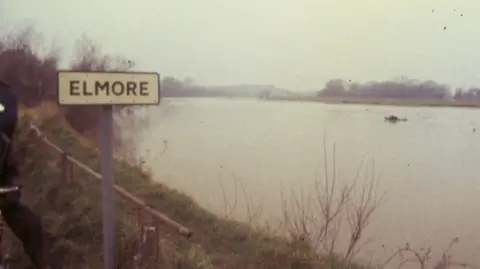Severn Bore's history: Dog cruelty and surfing firsts
People will gather on the banks of a river later to watch a world-famous natural phenomena roar through Gloucestershire. The Severn Bore occurs when a large tidal surge pushes up the River Severn against a current, causing towering waves. It's an event surfers don't want to miss, but in the past some unusual things happened including dog cruelty and surfing firsts.
Monday will see a "four star" bore weave its way up the river. The banks will be lined with wellie-wearing spectators, with surfers taking advantage in the water.
Records from the past few hundred years show how people have viewed the natural event.
A description of the bore from the 1700s, attributed to Sir Charles Blagden, a physician and secretary of the Royal Society in 1748, described how Gloucester residents would gather at "the Parting of the Water" at Alney Island.
The parting is a reference to how the river flows around the island before reuniting again near Maisemore.
"If the wind gets up the river, one can sometimes, even at this interval of time, hear a very distant roaring by putting the ear close to the water," he wrote.

But once the bore got closer, "about 200 yards off", Sir Blagden said, the way some onlookers celebrated its arrival was slightly disturbing.
He wrote: "There are commonly some men in boats to meet the tide, and some dogs are thrown in just as it comes, to observe their howling and distress.

"On a sudden, the boats and dogs are instantaneously raised up and thrown into violent agitation, and at the same time, a vast wave or wall of water... is seen approaching with extreme rapidity."
Sir Blagden added several ships had been lost to the bore, so watermen trading on the Severn were "extremely careful not to be taken disadvantageously by the head of the tide".
Elsewhere, he wrote that the bore rose to eight ft (2.4 metres) in height, and that he raced it on horseback between bends in the river in a bid to "overtake" the surge.
In the 20th Century, Arnold Whitehouse, senior science master at The Crypt School, studied the relationship shared between the tidal Severn and the moon.
'Unusually big tide'
Ahead of the bore on 17 November 1910, Mr Whitehouse wrote: "Such an unusually big tide so far from the equinoxes is due to the moon happening to be full on the same day it is at its nearest to the earth."
He claimed the bore that day was 30ft or 9.2m, the same height as the largest recorded bore would go on to be more than 50 years later in 1966.
In 1955, Colonel John Churchill, known as "Mad Jack", became the first person to surf the bore, standing atop a homemade board.
According to the Museum of British Surfing, this is thought of as being the first incidence of someone riding a tidal wave in a river.
The four star bore on Monday, which classed as a "large" bore, after being downgraded from a "very large" five star bore, will reach Minsterworth at 10:11 BST, Stonebench at 10:26 BST, and Over Bridge at 10:46 BST.
As the bore can arrive up to 20 minutes early or 30 minutes late, depending on weather conditions, those planning on watching are often advised to arrive early and find a good vantage point.
A three star bore will follow in the evening, reaching Minsterworth at 22:31 BST, Stonebench at 22:46 BST, and Over Bridge at 23:06 BST.
Follow BBC Gloucestershire on Facebook, X, and Instagram. Send your story ideas to us on email or via WhatsApp on 0800 313 4630.
